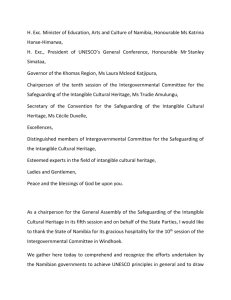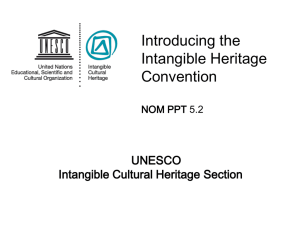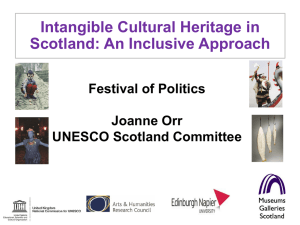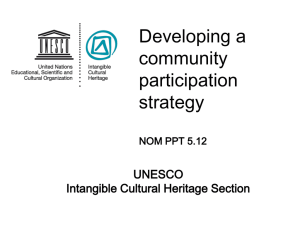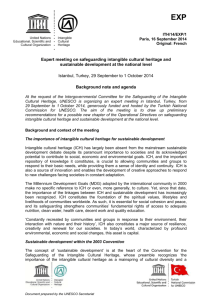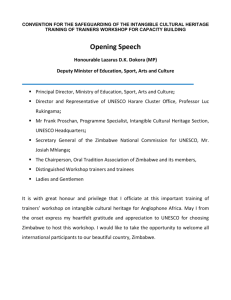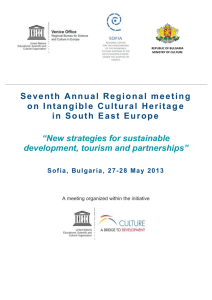WORK IN PROGRESS CONVENTION FOR THE SAFEGUARDING
advertisement
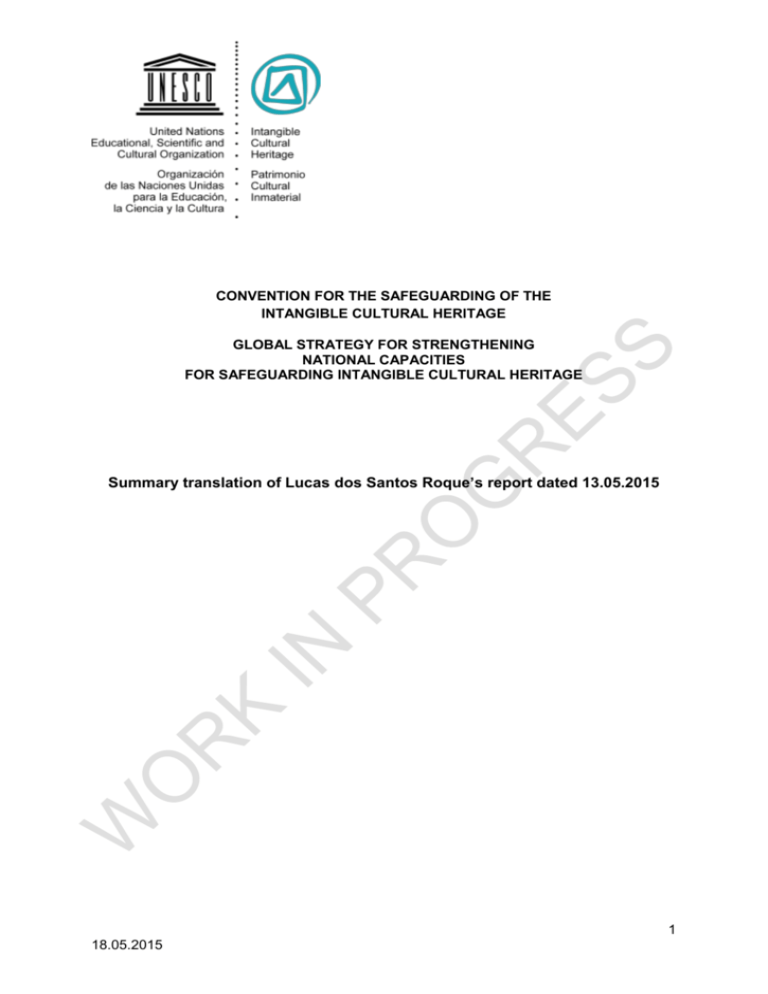
CONVENTION FOR THE SAFEGUARDING OF THE INTANGIBLE CULTURAL HERITAGE GLOBAL STRATEGY FOR STRENGTHENING NATIONAL CAPACITIES FOR SAFEGUARDING INTANGIBLE CULTURAL HERITAGE Summary translation of Lucas dos Santos Roque’s report dated 13.05.2015 1 18.05.2015 The present template has been developed by the UNESCO Intangible Cultural Heritage Section to help facilitators structure their capacity-building workshops reports and reflect on lessons learned according to a common framework of analysis. This will facilitate monitoring, information sharing and collective thinking on how to improve the workshop design and the capacity-building strategy at large. Workshop title : Inventory Workshop Workshop dates : 30/03/2015 to 10/04/2015 Workshop venue: Sao Tome, Sao Tome and Principe Country(ies) / region(s) covered by the workshop: Sao Tome and Principe, Mozambique and Cabo Verde Participants Total number: 40 Female: 11 Male: 29 Aged below 25 years: 6 Community members: 17 Ministry officials (also indicate name of ministry): 14 (Ministry of Culture) NGOs:0 Researchers: 8 Others: 1 (Government of Cabo Verde) Names of workshop facilitators : 1. Lucas dos Santos Roque (Brazil) 2. Alberto Folowara (Mozambique) Name of managing officer in charge and the name of the UNESCO field office Mojisola Okuribido – UNESCO Yaoundé Author of the report : Lucas dos Santos Roque Jana Weydt – UNESCO Paris 2 I. CONTEXT AND OBJECTIVES I.1 Describe briefly the country context and key features of the current professional and institutional environment for safeguarding intangible cultural heritage. The context is characterized by a difficulty to establish continuity in planned activities and dialogue. Since the workshop organized in 2012, real progress in strengthening intangible heritage policy has not been achieved due to continuous change in the government and respective technical teams, including those responsible for the implementation of this project. Furthermore, due to the low level of income in the country, participants as well as community members expected to receive financial compensation for their participation or contribution. Thus, every workshop participant received a lump sum to take part in the activity. This factor should be taken into consideration as it may compromise the future implementation of this project in STP. II.2 Recall the contribution and timing of this workshop in the context of larger ongoing efforts to build national capacity for safeguarding of intangible cultural heritage and recall the specific workshop objectives. The workshop on community-based inventory was held from 30/03 to 10/04/2015, in the city of Sao Tome as well as in the Community of Boa Morte (3km from Sao Tome). The objective was to consolidate methods of execution of community-based ICH inventory as well as the planning of inventory activities in the country. The workshop was important for national technicians to get familiar with participatory inventory methodologies for intangible cultural heritage and to sensitize the Minister of Culture on the importance of ensuring continuity in ICH safeguarding activities as well as the necessity to strengthen ICH policies at national level. II. PARTICIPANTS II.1 Who was there and what did they bring? Members of the community of Boa Morte, technicians from various institutions in the area of culture as well as a representative of Cabo Verde participated in the workshop. The presence of members of the community was crucial as most of them were bearers of the related cultural events. Five members of the National Committee on Intangible Cultural Heritage, created during the previous workshop on the implementation of the 2003 Convention held in 2012, have also taken part in the workshop. Their participation was important to raise the level of discussions as well as to establish a solid base in conducting national inventories as they will be in charge of such activities. Furthermore, the Director General of Culture and the Director of the National Museum, who also is the General Secretary of the National Commission of Sao Tome and Principe for UNESCO, participated in the workshop as well as Councillors for Culture from various parts of the country. The presence of those Councillors, most of them young, was to ensure a solid local base when conducting national inventories. Finally, an anthropologist from an important private company also participated in the workshop. This company is a potential partner in the inventory process of Auto Floripes, main cultural event of Principe Island. The anthropologist played an important role in 3 identifying the cultural heritage of Principe. II.2 How did the gender distribution affect the workshop dynamics? Although lower in number, women played an important role in the workshop’s thematic discussions, thanks to their solid experience in the area. They often took over leading roles in group works. II.3 How was youth (below 25) integrated and what was the added value of their participation? Despite their low proportion (6/40), young people seemed to have gone through an important learning process in regards to ICH, in how to present their point of view and build their capacities in this area. Young people are quite active in the community of Boa Morte and responsible for the mobilization of other community members. They have been promoting many cultural meetings and their presence was important to sensitize on ICH. III. STRONG POINTS & CHALLENGES III.1 What went well? The role of a devoted and Portuguese speaking project coordinator at Headquarters remains crucial to for the workshop’s implementation and to ensure the smooth and close cooperation for the preparations between the UNESCO Offices at Headquarters and Yaoundé as well as the 2 co-facilitators. Logistic aspects, such as catering, transport and infrastructure, were very good, although the physical space dedicated to the field work was a bit precarious, yet reflecting the local reality. The mobilization of the community was a bit weak but quite good taking into account the absence of financial compensation for information providers. III.2 What were the challenges and how were they overcome? The first challenge faced was the definition of the number of participants and the mobilization of the local community. Technicians from the area of culture have been privileged at the expense of the local community. Only one representative of the local community participated in the first part of the workshop. During the field exercise, local community mobilization was a bit weak (only 5-6 persons) and information on the workshop had not been well communicated by the authorities. Upon arrival the facilitators briefed the few present community members and requested them to mobilize other members of the community, in particular young people and women. During the exercise, the technicians easily took over the works at the few computers available (5 in total), excluding at times the community members from the process of filling in the inventory registers. The reason for the low mobilization of the local community and the tendency to privilege technicians in the inventory process and elaboration of texts is due to an institutional culture of centralization of decision and policy-making processes. Two issues should be further emphasized here: the low quality of some inventory records and the question of the financial compensation that has been asked both to participate in the workshop and to provide information. This last point was a frequent topic addressed during the workshop. IV. ISSUES DISCUSSED 4 What were some of the key issues that emerged from your exchanges with the participants? 1. The importance of the methodology for a community-based inventory and the change of paradigm induced. 2. The continuity of the work of the National Committee on Intangible Heritage and the development of a road map. This 2 years’ work plan has the objective of inventorying the ICH elements of the Community of Boa Morte, as well as the Auto Floripes (Representative List (RL)), the Txiloli and the Congo dance (Urgent Safeguarding List) in order to present the nominations to UNESCO’s lists. 3. Elaborating inventories and presenting nominations to UNESCO’s lists as well as the possibility to request resources from the UNESCO Intangible Cultural Heritage Fund to safeguard elements, which a are mainly threatened. V. LEARNING ACHIEVEMENT How do you assess participants’ learning achievement and what lessons should be considered for future workshops? The achievements in terms of learning process are quite positive. The process of mastering the participatory diagnostic tools as well as the participatory and inclusive approach needs, of course, time to be further internalized. However, the main objective of the workshop was reached: understanding the change needed to conduct a communitybased inventory work. VI. FACILITATOR’S PERFORMANCE How do you assess your role(s) and performance as facilitator? Positively, the main positive points were: 1. The didactic of group work and discussion on community-based inventory process used; 2. The strategy to propose actions focusing on the continuity of the processes and activities developed in the frame of the workshop. 3. The presence of a co-facilitator was a positive experience and proved to be very beneficial as it allowed a better division of activities and follow-up of participants’ work. The preparation of the workshop can, however, still be improved notably by increasing the communication between the facilitators prior to the workshop. VII. STRUCTURE AND MATERIALS What do you conclude and recommend in terms of the workshop structure, duration and training materials? The structure of the workshop is adequate, starting with a theoretical part, followed by field work and finally concluded by desk to systematize the collected information and plan future inventory activities. Despite the dynamic character of this structure, participants complained about the duration of daily activities, which they claimed to be too long and tiring. 5 Materials provided by UNESCO are of high quality. Their new format and structure will be even more adapted and relevant. VIII. ADDED VALUE Has the workshop succeeded in adding value to national efforts of building capacity for the effective implementation of the 2003 Convention? The workshop contributed to spread the concept of ICH, thanks notably to the participation of the community, technicians and local councillors from the culture area. Moreover, TV advertisement and coverage of the workshop and intangible cultural heritage have been broadcasted by the local television. Furthermore, the workshop contributed to the reinforcement of the ICH national committee and its roadmap. Three meetings with the Minister of Education, Science and Culture, were organized in order to raise awareness on the importance of ICH. These meetings elucidated on the future national development plans with respect to culture, such as the creation of a Cultural Heritage Institute, which will be responsible for the management of the National Cultural Heritage. Finally, in Principe Islands, local communities were enthusiastic about the idea to present the “Auto Flores” to the RL. IX. CONCLUSIONS AND RECOMMENDATIONS IX.1 In light of your analysis, what would you like to recommend to further improve the design and delivery of the global capacity-building strategy? Three important aspects can contribute to improve the design and delivery of the global capacity-building strategy, mentioned in my previous report: 1. Despite the high quality of the training materials provided, they do not address clearly the necessity to understand the institutional structure of the country and related constraints to implement the 2003 Convention. In this respect, the workshop only focuses on the Convention itself and not on the country. As a consequence, no room is foreseen to discuss potentialities and institutional weaknesses for the development of the work for ICH safeguarding at national level. This missing link to the national reality may empty the workshops of their sense and may ultimately impede adequate follow-up. Understanding and discussing such questions is fundamental to ensure continuity of activities and the possibility for participants to apply knowledge and skills acquired. 2. The elaboration of action plans after each workshop is essential to cope with the difficulty of participants to apply knowledge and skills acquired. These action plans ensure, thereby, continuity of works carried out during the workshop, define responsible persons and serve as a source of inspiration. Thus, action plans increase chances that participants successfully assimilate content developed during the workshop. 3. The production of synthesis documents containing information from the inventory proved to be an extremely positive outcome with an important multiplying effect: (1) the community becomes aware of the concrete result of the exercise, and can (2) use the material for safeguarding purposes, as well as (3) promotional purposes to raise awareness about their heritage at local, regional and national level. 6 IX.2 Based on the experience of this workshop do you have any advice or recommendation to the beneficiary country to further improve the professional and institutional environment for safeguarding intangible cultural heritage? The country should use the information gathered during the inventory exercise in the community of Boa Morte and elsewhere to conduct a television campaign on the notion of Intangible Cultural Heritage and its importance for the development of the country. The issue related to the financial compensation requested by technicians and members of the community needs careful consideration in order to ensure the continuity of works carried out during the workshop. However, this should not compromise the real aim of the activity, which is the mobilization for ICH safeguarding. By no means it should turn into a paid/lucrative activity. X. KEY MESSAGES Please formulate two or three key messages regarding this workshop that could be used for communication purposes, notably for the UNESCO ICH web news. (Approximately 250 words) Within the framework of the Global capacity building strategy for the safeguarding of Intangible Cultural Heritage, UNESCO organized a community-based inventory workshop in Sao Tome and Principe. Activities have been carried out by technicians from all across the country and held in the Community of Boa Morte, who actively took part in as well. Over than twenty cultural events have been identified, reflecting the great cultural diversity of the country. 7
